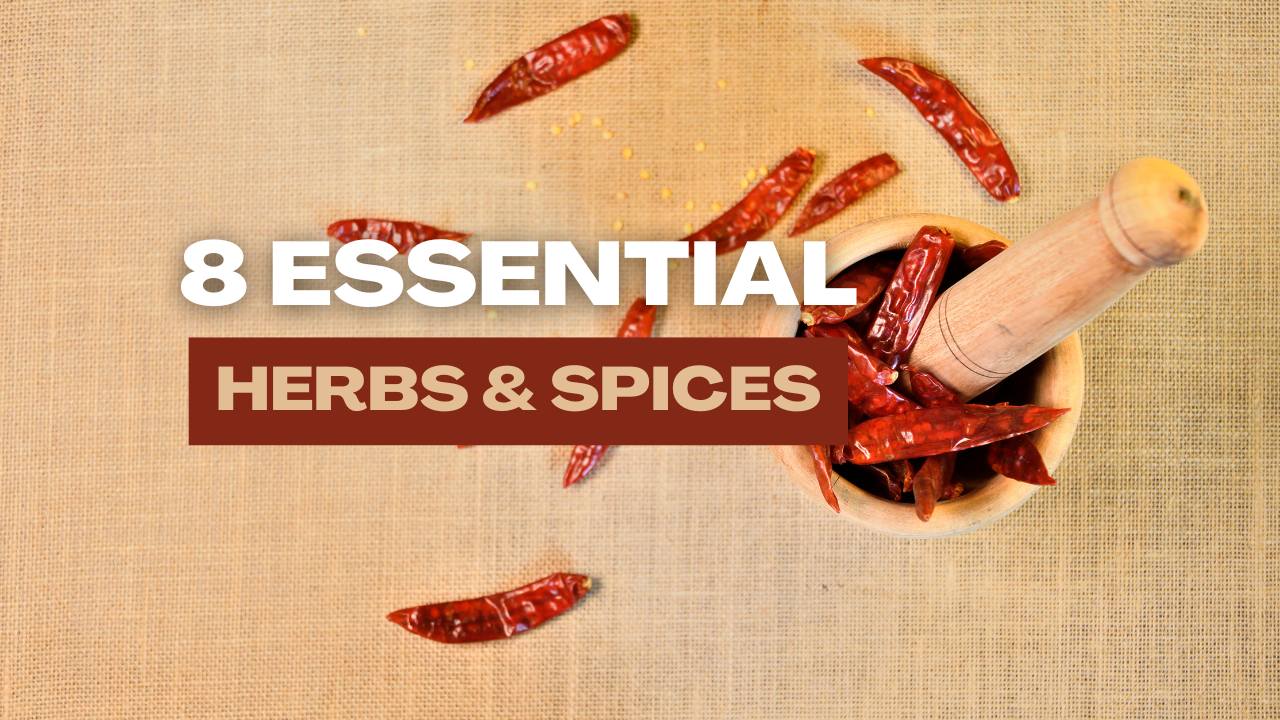A well-stocked spice rack is the secret weapon of many great cooks. Herbs and spices not only add flavor and depth to your dishes but also come with numerous health benefits. Whether you’re a novice cook or a seasoned chef, having these eight essential herbs and spices in your kitchen will elevate your culinary creations and expand your cooking repertoire.
1. Black Pepper
Black pepper is perhaps the most ubiquitous spice in kitchens around the world, and for good reason.
Flavor Profile: Pungent, sharp, and slightly spicy Culinary Uses:
- Enhances flavor in almost any savory dish
- Great in marinades, rubs, and as a finishing touch
- Pairs well with most other herbs and spices
Health Benefits: Contains piperine, which may enhance nutrient absorption and have anti-inflammatory properties.
Pro Tip: Invest in a good pepper grinder and grind your peppercorns fresh for the best flavor.
2. Cinnamon
Cinnamon is a versatile spice that bridges the gap between sweet and savory dishes.
Flavor Profile: Sweet, warm, and slightly woody Culinary Uses:
- Essential in many baked goods and desserts
- Adds warmth to savory dishes, especially in Middle Eastern and North African cuisines
- Great in coffee, tea, and hot chocolate
Health Benefits: May help regulate blood sugar levels and has antioxidant properties.
Pro Tip: There are two main types of cinnamon: Ceylon (considered « true » cinnamon) and Cassia. Ceylon has a milder, more complex flavor, while Cassia is stronger and more common in supermarkets.
3. Basil
Basil is a fragrant herb that’s a staple in many cuisines, especially Italian and Southeast Asian.
Flavor Profile: Sweet, peppery, with a slight anise flavor Culinary Uses:
- Essential in Italian dishes like pesto and Caprese salad
- Adds freshness to Thai and Vietnamese dishes
- Great in salads, sandwiches, and as a pizza topping
Health Benefits: Rich in antioxidants and may have anti-inflammatory properties.
Pro Tip: Add fresh basil at the end of cooking to preserve its flavor and aroma.
4. Cumin
Cumin is a warm, earthy spice that’s crucial in many global cuisines.
Flavor Profile: Earthy, warm, with a slight bitterness Culinary Uses:
- Essential in many Indian, Middle Eastern, and Mexican dishes
- Great in chili, curries, and spice rubs for meats
- Adds depth to vegetable dishes and soups
Health Benefits: May aid digestion and have anti-diabetic properties.
Pro Tip: Toasting whole cumin seeds before grinding can enhance their flavor significantly.
5. Garlic Powder
While fresh garlic is irreplaceable in many dishes, garlic powder offers convenience and a different flavor profile.
Flavor Profile: Pungent, savory, with a sweeter and less aggressive garlic flavor than fresh Culinary Uses:
- Great in dry rubs for meats
- Adds garlic flavor to soups, sauces, and dressings without changing texture
- Useful in garlic bread and other baked goods
Health Benefits: Contains allicin, which may have cardiovascular benefits and boost the immune system.
Pro Tip: Garlic powder can burn easily, so add it towards the end of cooking in high-heat dishes.
6. Oregano
Oregano is a robust herb that’s essential in Mediterranean and Mexican cuisines.
Flavor Profile: Pungent, with a balance of sweet and spicy notes Culinary Uses:
- Classic in Italian-American dishes like pizza and pasta sauces
- Great in Greek salads and with grilled meats
- Adds depth to Mexican dishes
Health Benefits: Has antimicrobial properties and is rich in antioxidants.
Pro Tip: Mediterranean oregano (Greek or Italian) has a milder flavor than Mexican oregano, which is stronger and pairs well with chili peppers.
7. Paprika
Paprika is a versatile spice made from ground peppers, ranging from sweet to hot.
Flavor Profile: Can range from sweet and mild to hot and pungent Culinary Uses:
- Adds color and flavor to Hungarian and Spanish dishes
- Great in spice rubs for meats and in egg dishes
- Adds depth to soups and stews
Health Benefits: Rich in antioxidants, particularly vitamin C and carotenoids.
Pro Tip: Store paprika in the refrigerator to preserve its color and flavor.
8. Turmeric
Turmeric has gained popularity not only for its flavor but also for its potential health benefits.
Flavor Profile: Earthy, slightly bitter, with a peppery aroma Culinary Uses:
- Essential in many Indian dishes and curries
- Adds color and earthiness to rice dishes and soups
- Great in smoothies and golden milk
Health Benefits: Contains curcumin, which has powerful anti-inflammatory and antioxidant properties.
Pro Tip: Combine turmeric with black pepper to enhance the absorption of curcumin.
Storing Your Herbs and Spices
To ensure your herbs and spices retain their flavor and potency:
- Store them in airtight containers away from heat and light.
- Keep dried herbs and ground spices for no more than 1-2 years.
- Whole spices can last up to 4 years when stored properly.
- Label your spices with the purchase date to keep track of freshness.
Conclusion
These eight herbs and spices form a solid foundation for a well-stocked kitchen. They offer a wide range of flavors that can enhance various cuisines and dishes. As you become more comfortable with these basics, don’t be afraid to explore other herbs and spices to expand your culinary horizons.
Remember, the key to using herbs and spices effectively is to start with small amounts and adjust to your taste. With practice, you’ll develop an intuition for how to combine these flavors to create delicious, well-balanced dishes.
Whether you’re whipping up a quick weeknight dinner or preparing a feast for friends and family, having these essential herbs and spices on hand will ensure you’re always ready to add a burst of flavor to your culinary creations.






